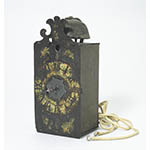The iron case of this clock is in the shape of a pavilion with hinged doors on the sides. The painted dial is simple, with Roman hour numerals. The small alarm disk carries the numbers 1 to 12 in Arabic numerals. The movement is driven by a weight with rope. The train has three iron wheels, with an upright verge and balance above the frame. Was converted into a pendulum movement oscillating in front of the dial, with alterations to the train and escapement; more recently, it was reconverted into a balance movement. The alarm mechanism is original, and its large contrate wheel has 17 teeth. The two-headed hammer can be stopped by means of an ingenious arrangement and a small lever, which have survived. The alarm and frame constitute an innovative system that provides a significant example of late-Renaissance Italian technology in the construction of small hanging clocks.










